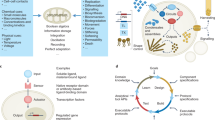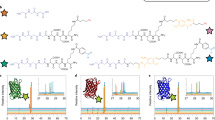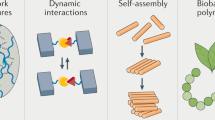Abstract
Engineering the surface chemistry of a material so that it can interface with cells is an extraordinarily demanding task. The surface of a cell is composed of thousands of different lipids, proteins and carbohydrates, all intricately (and dynamically) arranged in three dimensions on multiple length scales. This complexity presents both a challenge and an opportunity to chemists working on bioactive interfaces. Here we discuss how some of these challenges can be met with interdisciplinary material synthesis. We also review the most popular classes of functional molecules grafted on engineered surfaces and explore some alternatives that may offer greater flexibility and specificity. Finally, we discuss the emerging field of dynamic surfaces capable of stimulating and responding to cellular activity in real time.
This is a preview of subscription content, access via your institution
Access options
Subscribe to this journal
Receive 12 print issues and online access
$259.00 per year
only $21.58 per issue
Buy this article
- Purchase on Springer Link
- Instant access to full article PDF
Prices may be subject to local taxes which are calculated during checkout




Similar content being viewed by others
References
Apple, D. J. Nicholas Harold Lloyd Ridley. 10 July 1906 — 25 May 2001. Biogr. Mem. Fellows R. Soc. 53, 285–307 (2007).
Derda, R. et al. High-throughput discovery of synthetic surfaces that support proliferation of pluripotent cells. J. Am. Chem. Soc. 132, 1289–1295 (2010).
Anstee, D. J. The nature and abundance of human red cell surface glycoproteins. J. Immunogenet. 17, 219–225 (1990).
Chen, W. T. & Singer, S. J. Immunoelectron microscopic studies of the sites of cell-substratum and cell-cell contacts in cultured fibroblasts. J Cell Biol. 95, 205–222 (1982).
Arnold, M. et al. Activation of integrin function by nanopatterned adhesive interfaces. Chemphyschem 5, 383 (2004).
Hersel, U., Dahmen, C. & Kessler, H. RGD modified polymers: biomaterials for stimulated cell adhesion and beyond. Biomaterials 24, 4385–4415 (2003).
Hirschfeld-Warneken, V. C. et al. Cell adhesion and polarisation on molecularly defined spacing gradient surfaces of cyclic RGDfk peptide patches. Eur. J. Cell Biol. 87, 743–750 (2008).
Boturyn, D., Coll, J. L., Garanger, E., Favrot, M. C. & Dumy, P. Template assembled cyclopeptides as multimeric system for integrin targeting and endocytosis. J. Am. Chem. Soc. 126, 5730–5739 (2004).
Martins, M. D. F. & Bairos, V. A. Glycocalyx of lung epithelial cells. Int. Rev. Cytol. 216, 131–173 (2002).
Tateno, H. et al. A novel strategy for mammalian cell surface glycome profiling using lectin microarray. Glycobiology 17, 1138–1146 (2007).
Nieuwdorp, M. et al. Measuring endothelial glycocalyx dimensions in humans: a potential novel tool to monitor vascular vulnerability. J. Appl. Physiol. 104, 845–852 (2008).
Pierres, A., Benoliel, A. M., Touchard, D. & Bongrand, P. How cells tiptoe on adhesive surfaces before sticking. Biophys. J. 94, 4114–4122 (2008).
Zeck, G. & Fromherz, P. Repulsion and attraction by extracellular matrix protein in cell adhesion studied with nerve cells and lipid vesicles on silicon chips. Langmuir 19, 1580–1585 (2003).
Beer, J. H., Springer, K. T. & Coller, B. S. Immobilized Arg-Gly-Asp (RGD) peptides of varying lengths as structural probes of the platelet glycoprotein-IIb/IIIa receptor. Blood 79, 117–128 (1992).
Kuhlman, W., Taniguchi, I., Griffith, L. G. & Mayes, A. M. Interplay between PEO tether length and ligand spacing governs cell spreading on RGD-modified PMMA-g-PEO comb copolymers. Biomacromolecules 8, 3206–3213 (2007).
Harris, B. P. & Metters, A. T. Generation and characterization of photopolymerized polymer brush gradients. Macromolecules 39, 2764–2772 (2006).
Tomlinson, M. R. & Genzer, J. Formation of grafted macromolecular assemblies with a gradual variation of molecular weight on solid substrates. Macromolecules 36, 3449–3451 (2003).
Lamanna, W. C. et al. The heparanome—the enigma of encoding and decoding heparan sulfate sulfation. J. Biotechnol. 129, 290–307 (2007).
Lanner, F. et al. Heparan sulfation-dependent fibroblast growth factor signaling maintains embryonic stem cells primed for differentiation in a heterogeneous state. Stem Cells 28, 191–200 (2009).
Curtis, A. S. G. The competitive effects of serum proteins on cell adhesion. J. Cell. Sci. 71, 17–35 (1984).
Gray, J. J. The interaction of proteins with solid surfaces. Curr. Opin. Struct. Biol. 14, 110–115 (2004).
Stevens, M. M. & George, J. H. Exploring and engineering the cell surface interface. Science 310, 1135–1138 (2005).
Massia, S. P. & Hubbell, J. A. Covalent surface immobilization of Arg-Gly-Asp-containing and Tyr-Ile-Gly-Ser-Arg-containing peptides to obtain well-defined cell-adhesive substrates. Anal. Biochem. 187, 292–301 (1990).
Pierschbacher, M. D. & Ruoslahti, E. Influence of stereochemistry of the sequence Arg-Gly-Asp-Xaa on binding specificity in cell adhesion. J. Biol. Chem. 262, 17294–17298 (1987).
Kolhar, P., Kotamraju, V. R., Hikita, S. T., Clegg, D. O. & Ruoslahti, E. Synthetic surfaces for human embryonic stem cell culture. J. Biotechnol. 146, 143–146 (2010).
Kam, L., Shain, W., Turner, J. N. & Bizios, R. Selective adhesion of astrocytes to surfaces modified with immobilized peptides. Biomaterials 23, 511–515 (2002).
Massia, S. P. & Hubbell, J. A. Immobilized amines and basic amino acids as mimetic heparin-binding domains for cell-surface proteoglycan-mediated adhesion. J. Biol. Chem. 267, 10133–10141 (1992).
Cardin, A. D. & Weintraub, H. J. R. Molecular modeling of protein-glycosaminoglycan interactions. Arterioscler. Thromb. Vasc. Biol. 9, 21–32 (1989).
Rezania, A. & Healy, K. E. Biomimetic peptide surfaces that regulate adhesion, spreading, cytoskeletal organization, and mineralization of the matrix deposited by osteoblast-like cells. Biotechnol. Prog. 15, 19–32 (1999).
Weis, W. I. & Drickamer, K. Structural basis of lectin-carbohydrate recognition. Annu. Rev. Biochem. 65, 441–473 (1996).
Sharon, N. & Lis, H. in Molecular Immunology of Complex Carbohydrates 2 (ed. Wu, A. M.) 1–16 (Springer, 2001).
Oka, J. A. & Weigel, P. H. Binding and spreading of hepatocytes on synthetic galactose culture surfaces occur as distinct and separable threshold responses. J. Cell. Biol. 103, 1055–1060 (1986).
Griffith, L. G. & Lopina, S. Microdistribution of substratum-bound ligands affects cell function: hepatocyte spreading on PEO-tethered galactose. Biomaterials 19, 979–986 (1998).
Anderson, D. G., Levenberg, S. & Langer, R. Nanoliter-scale synthesis of arrayed biomaterials and application to human embryonic stem cells. Nature Biotechnol. 22, 863–866 (2004).
Blixt, O. et al. Printed covalent glycan array for ligand profiling of diverse glycan binding proteins. Proc. Natl Acad. Sci. USA 101, 17033–17038 (2004).
Plante, O. J., Palmacci, E. R. & Seeberger, P. H. Automated solid-phase synthesis of oligosaccharides. Science 23, 1523–1527 (2001).
Luo, W., Chan, E. W. L. & Yousaf, M. N. Tailored electroactive and quantitative ligand density microarrays applied to stem cell differentiation. J. Am. Chem. Soc. 132, 2614–2621 (2010).
Steinman, R. M., Brodie, S. E. & Cohn, A. Z. Membrane flow during pinocytosis: a stereologic analysis. J. Cell. Biol. 68, 665–687 (1976).
Discher, D. E., Janmey, P. & Wang, Y-l. Tissue cells feel and respond to the stiffness of their substrate. Science 310, 1139–1143 (2005).
Deeg, J. et al. Impact of local versus global ligand density on cellular adhesion. Nano Lett. 11, 1469–1476 (2011).
Zhong, C. et al. Rho-mediated contractility exposes a cryptic site in fibronectin and induces fibronectin matrix assembly. J. Cell. Biol. 141, 539–551 (1998).
Lahann, J. et al. A reversibly switching surface. Science 299, 371–374 (2003).
Raeber, G. P., Lutolf, M. P. & Hubbell, J. A. Molecularly engineered PEG hydrogels: a novel model system for proteolytically mediated cell migration. Biophys. J. 89, 1374–1388 (2005).
Lutolf, M. P. et al. Synthetic matrix metalloproteinase-sensitive hydrogels for the conduction of tissue regeneration: engineering cell-invasion characteristics. Proc. Natl Acad. Sci. USA 100, 5413–5418 (2003).
Palecek, S. P., Schmidt, C. E., Lauffenburger, D. A. & Horwitz, A. F. Integrin dynamics on the tail region of migrating fibroblasts. J. Cell. Sci. 109, 941–952 (1996).
Yeo, W. S., Yousaf, M. N. & Mrksich, M. Dynamic interfaces between cells and surfaces: electroactive substrates that sequentially release and attach cells. J. Am. Chem. Soc. 125, 14994–14995 (2003).
Lee, E-J., Chan, E. W. L. & Yousaf, M. N. Spatio-temporal control of cell coculture interactions on surfaces. ChemBioChem 10, 1648–1653 (2009).
Holland, N. B., Qiu, Y., Ruegsegger, M. & Marchant, R. E. Biomimetic engineering of non-adhesive glycocalyx-like surfaces using oligosaccharide surfactant polymers. Nature 392, 799–801 (1998).
Koo, L. Y., Irvine, D. J., Mayes, A. M., Lauffenburger, D. A. & Griffith, L. G. Co-regulation of cell adhesion by nanoscale RGD organization and mechanical stimulus. J. Cell. Sci. 115, 1423–1433 (2002).
Wischerhoff, E. et al. Controlled cell adhesion on PEG-based switchable surfaces. Angew. Chem. Int. Ed. 47, 5666–5668 (2008).
Lutz, J. F., Akdemir, O. & Hoth, A. Point by point comparison of two thermosensitive polymers exhibiting a similar LCST: is the age of poly(NIPAm) over? J. Am. Chem. Soc. 128, 13046–13047 (2006).
Yu, X., Wang, Z. Q., Jiang, Y. G., Shi, F. & Zhang, X. Reversible pH-responsive surface: from superhydrophobicity to superhydrophilicity. Adv. Mater. 17, 1289–1293 (2005).
Renner, C. & Moroder, L. Azobenzene as conformational switch in model peptides. ChemBioChem 7, 868–878 (2006).
Collier, J. H. & Mrksich, M. Engineering a biospecific communication pathway between cells and electrodes. Proc. Natl Acad. Sci. USA 103, 2021–2025 (2006).
Jensen, H. M. et al. Engineering of a synthetic electron conduit in living cells. Proc. Natl Acad. Sci. USA 107, 19213–19218 (2010).
Place, E. S., Evans, N. D. & Stevens, M. M. Complexity in biomaterials for tissue engineering. Nature Mater. 8, 457–470 (2009).
Aguilar, Z. et al. Biologic effects of heregulin/neu differentiation factor on normal and malignant human breast and ovarian epithelial cells. Oncogene 18, 6050–6062 (1999).
Juliano, R. L. Signal transduction by cell adhesion receptors and the cytoskeleton: functions of integrins, cadherins, selectins and immunoglobulin-superfamily members. Annu. Rev. Pharmacol. Toxicol. 42, 283–323 (2002).
Shin, H., Jo, S. & Mikos, A. G. Biomimetic materials for tissue engineering. Biomaterials 24, 4353–4364 (2003).
Acknowledgements
We thank J. Weaver for constructive reading of this manuscript. M.M.S. thanks ERC starting investigator grant “Naturale” for funding.
Author information
Authors and Affiliations
Corresponding author
Ethics declarations
Competing interests
The authors declare no competing financial interests.
Rights and permissions
About this article
Cite this article
Mager, M., LaPointe, V. & Stevens, M. Exploring and exploiting chemistry at the cell surface. Nature Chem 3, 582–589 (2011). https://doi.org/10.1038/nchem.1090
Published:
Issue Date:
DOI: https://doi.org/10.1038/nchem.1090
This article is cited by
-
BDNF-loaded PDADMAC-heparin multilayers: a novel approach for neuroblastoma cell study
Scientific Reports (2023)
-
The five Ferulago species inhibited cell proliferation and induced apoptosis of A549, MCF-7, PC3 and SW480 cancer cells in vitro
3 Biotech (2023)
-
Self-assembly of DNA molecules at bio-interfaces and their emerging applications for biomedicines
Nano Research (2023)
-
Current hydrogel advances in physicochemical and biological response-driven biomedical application diversity
Signal Transduction and Targeted Therapy (2021)
-
Dual mechanism β-amino acid polymers promoting cell adhesion
Nature Communications (2021)



